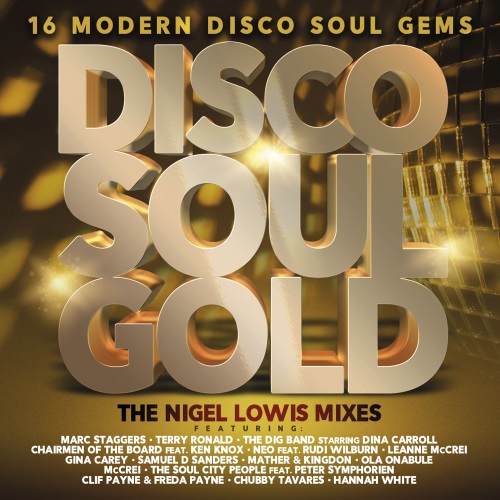Disco Soul Gold: The Nigel Lowis Mixes (2017)
A mid-July promotion to invite baseball and music fans to blow up a crate of disco records in between a double header pitting a mediocre baseball team and a bad one was a good way to guarantee a sellout. However, the July 12, 1979 promotion known as Disco Demolition Night had some unforeseen consequences. For one thing, the amped and liquored up fans charged the field after the crate’s detonation, damaging the turf at Comiskey Park, the home of the Chicago White Sox. The ensuing riot caused the game to be forfeited, and it went into the record books as one of the White Sox’s 89 L’s. Thus the ’79 Sox joined the 1974 Cleveland Indians (ten cent beer night) as first ballot entries in the when sports promotions go wrong hall of fame.
Disco Soul Gold: The Nigel Lowis Mixes (2017)
A mid-July promotion to invite baseball and music fans to blow up a crate of disco records in between a double header pitting a mediocre baseball team and a bad one was a good way to guarantee a sellout. However, the July 12, 1979 promotion known as Disco Demolition Night had some unforeseen consequences. For one thing, the amped and liquored up fans charged the field after the crate’s detonation, damaging the turf at Comiskey Park, the home of the Chicago White Sox. The ensuing riot caused the game to be forfeited, and it went into the record books as one of the White Sox’s 89 L’s. Thus the ’79 Sox joined the 1974 Cleveland Indians (ten cent beer night) as first ballot entries in the when sports promotions go wrong hall of fame.
More ominously for the music, Disco Demolition Night revealed a big cultural divide between the largely white and male rock fans and the primarily black, Latino and gay fans of disco. There are several documentaries that explore this topic. Minorities recounting the night talk about the racial and cultural resentments manifested themselves, and whites saying that the reaction had nothing to do with race. One thing all can agree on is that Disco Demolition Night marked the beginning of the end of disco’s ascent, though disco never came close to being demolished as an art form and cultural force. Careers were certainly damaged by the backlash, but performers such as Nile Rogers and disco queen Donna Summer had successful second acts. Rogers, one of the creative forces behind the band Chic, became a successful producer of pop stars such as Madonna during the 1980s.
Disco’s endurance stems from the fact that a genre that at its best combines the church based rhythms of funk and soul, with jazzy swing of big band music and the lush instrumentation of Broadway tunes. The formula created a style of music that led many people to rediscover couple dancing, and it is what propels the 16-track compilation Disco Soul Gold, from the record label of the same name. In fact, Disco Soul Gold showcases the range of musical styles that fit under disco’s broad tent, as well. The compilation is an unabashed embrace of the music in all of its diversity while also revealing the depth of the genre’s influence on future musical styles.
The use of original tunes performed by artists who were active during the disco era, such as Chubby Tavares and Freda Payne, as well as contemporary indie soul singers like Mark Staggers and Leanne McCrae, will help people listen to this genre with a new set of ears. Those who take the challenge will hear Chairmen of the Board, the group known for hits such as “Give Me Just a Little More Time,” fuse funk and disco on “Reach Out to Me,” an up-tempo dance number that features a propulsive bass line and the smoky vocals of longtime Chairmen member Ken Knox.
Tavares uses the same disco funk formula while delivering a political message that is suited for what is going on in 2017 on “Can’t Knock Me Down.” Meanwhile, the duet “No Pain, No Gain,” finds Payne remaining in fine voice on a cut with shows how the Philadelphia International Records, with its lush arrangements, influenced the disco movement.
The synthesizers and pulsating bass line on “Sunny Day” – featuring vocalist Hannah White - highlights how disco served as the foundation for house and techno music of the 1980s. The lyrics, which tell the story of a couple exploring Manhattan, is a reminder of the central role that New York played in the story of disco.
This album is called Disco Soul Gold, and voice of soul music is raised throughout, most notably in the Leanne McCray’s angelic vocals on the 1960s retro-soul track “Stay a Little Longer,” while Staggers lends his husky baritone to a smooth remake of the Isley Brothers classic “This Old Heart of Mine,” that is influenced by the smooth Quiet Storm R&B of the 1980s. He steps up the pace on the mid-tempo “Bring It Home to Me,” a cut that pairs the jazzy sing that disco brought to the game in the mid 1970s with the power packed adult male vocals that recalls singers such as Jeffrey Osborne and Teddy Pendergrass.
Disco’s influence can be heard in hip-hop, pop, house and EDM music. Longtime disco fans got a kick out of seeing Pharrell Williams and Rogers team with Daft Punk and win multiple Grammys singing what is essentially a disco song in “Get Lucky,” and if you needed further confirmation that disco indeed does NOT suck, Disco Soul Gold provides it. Highly Recommended.
By Howard Dukes

